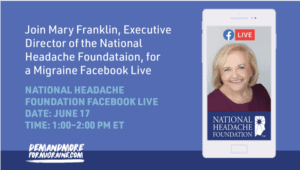In recognition of Migraine and Headache Awareness Month, the National Headache Foundation today announced findings from its Perspectives from People with Migraine survey, which highlights experiences of people with migraine disease, the tradeoffs made to manage their disease with current therapies and the impact of the disease on daily life.
The survey revealed that while two-thirds (65%) of people with migraine currently use triptans as an acute treatment, most seek relief across many treatment categories ranging from prescription drugs to over-the-counter pain killers to holistic or alternative medicine; oftentimes using multiple treatments sequentially to find relief. Despite treating their disease with a variety of therapies, less than a third of responders (29%) report feeling that their migraine is under control. Further, due to side effects such as brain fog, fatigue and sleepiness, on average almost half of the responders between the ages of 18-59 feel anxious (46%) upon taking treatment. In addition, in that same age group, 47% report that treatment side effects have interfered with their ability to go to school or work.
“Migraine disease is so much more than a headache. Due to the COVID-19 pandemic that has impacted our world, stress and anxiety, which are major triggers for people with migraine disease, are at an all-time high. We must strive to understand and educate about the impact of this disease on not only physical well-being; but also, emotional and mental health,” said Mary Franklin, executive director of the National Headache Foundation. “Every person living with migraine has a different experience and we want all to feel confident in their treatment choices; but also know that there are others who understand the real impact of the disease.”
Almost all responders felt misunderstood and feared they were a burden to family, friends, and colleagues.
- Nearly all (93%) people agreed that those who don’t suffer from migraine don’t understand the severity of the disease
- More than half (54%) report feeling like a burden to family, friends, and co-workers because of their disease
- More than half (53%) say they modified career plans and aspirations due to the impact of migraine
The survey also sheds light on the emotional and mental burden of the disease. Over three-quarters (77%) of responders said they were not able to do the things they wanted to because of migraine attacks. Responders reported the following due to a migraine attack at least once a week:
- 42% were unable to exercise or participate in physical activity
- 37% feel less productive at work or school
- 28% feel less able to take care of their children
- 25% avoid sexual intimacy
The survey was funded by Biohaven Pharmaceutical Holding Company Ltd. as part of the Demand More for Migraine (www.demandmoreformigraine.com) educational initiative.
“Biohaven is committed to raising awareness of the truly debilitating effects of migraine including the physical, mental and emotional burdens,” said Vlad Coric, M.D., chief executive officer of Biohaven. “By supporting this research with the NHF, we hope to better understand the tradeoffs people with migraine make every day living with this invisible disease, so we can continue to invest in resources and treatment options that address their unmet needs.”
About Perspectives from People with Migraine Survey
The Perspectives from People with Migraine was a 20-minute, online, quantitative opinion survey conducted by the National Headache Foundation and funded by Biohaven Pharmaceutical Holding Company Ltd. The survey was fielded in December 2019 through January 2020 and included responses from more than 1000 men and women aged 18-70+ who suffer from migraine, had at least one migraine attack in the month prior to survey participation, and have been diagnosed with migraine by a physician for three or more years. A sub-analysis of the outcomes focused on the experiences of adults aged 18 – 59.
 We are hosting a Facebook Live on 6/17 at 1 PM ET to dive deeper into our migraine survey results. Tune in to ask questions and hear more about what we learned from people living with migraine disease.
We are hosting a Facebook Live on 6/17 at 1 PM ET to dive deeper into our migraine survey results. Tune in to ask questions and hear more about what we learned from people living with migraine disease.
